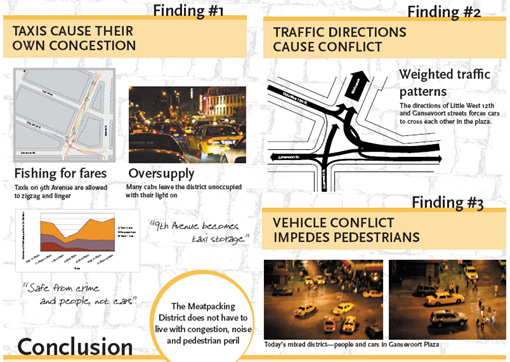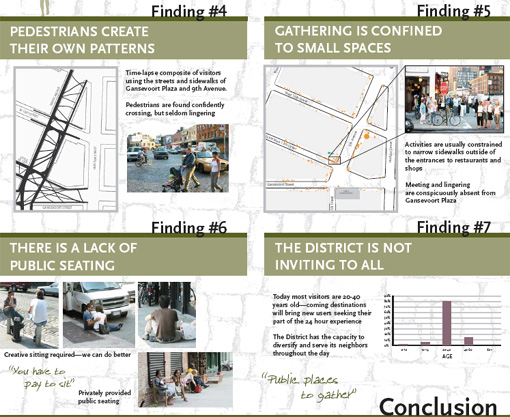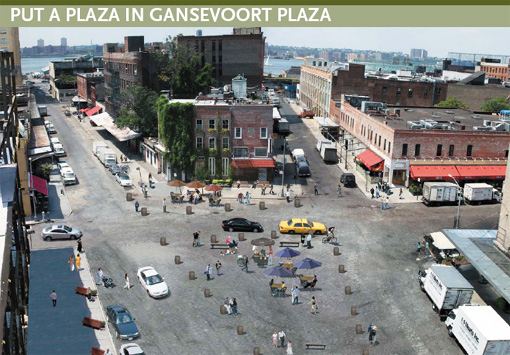A New Vision for the Meatpacking District
The Gansevoort Project Aims to Turn a Chaotic Intersection into a Grand Piazza 
At Manhattan Borough President Scott Stringer’s transportation policy conference last week, DOT Commissioner Iris Weinshall said she was committed to working "with communities and other city agencies to reallocate street space" to "create public plazas in neighborhoods in all five boroughs."
"These open spaces," Weinshall said, "will make walking more enjoyable, preserve neighborhood character, and can serve as the heart of a neighborhood through which all activity can pulse."
The Commissioner’s vision of community collaboration producing great new public spaces is a refreshing departure from DOT’s traditional, top-down, engineer-driven focus on moving cars and trucks to "maximize vehicular level of service." The question is: How is Weinshall going to make it happen? How will New York City’s Department of Transportation transform itself into something more like a Department of Streets and Public Spaces?
An answer to that question appears to be materializing along the cobblestone streets of Manhattan’s Meatpacking District. Flying below the radar for more than a year now, a community-driven initiative to transform the broad, chaotic intersection of Ninth Avenue and Gansevoort Street into a thriving piazza is well underway. In the process, the Greater Gansevoort Urban Improvement Project (GGUIP) is quietly emerging as one of New York City’s most promising Streets Renaissance initiatives.
What is, perhaps, most notable about the Gansevoort Project is that it isn’t being put forward by a big real estate developer or Deputy Mayor Dan Doctoroff’s Economic Development Corporation. Rather, it is a grassroots, community-driven effort. If city officials and Livable Streets advocates want a concrete example of how to make Commissioner Weinshall’s public space vision a reality, this is the project to keep an eye on.

The Gansevoort Project is the brainchild of two neighborhood stalwarts, preservationist Jo Hamilton and restaurateur Florent Morellet. Last Monday evening, Hamilton and Morellet convened 150 residents and business owners from around the Meatpacking District to meet with an impressive group of experts and elected officials to share ideas and hammer out a collective vision for their neighborhood.
The process began in early 2005, when Project for Public Spaces began working with business owners and local residents to define problems, identify best practices, and formulate a vision for what people wanted their neighborhood to be (Click here to download PPS’s findings). PPS’s philosophy is that "If you plan a city for cars and traffic you get cars and traffic. If you plan for people and places, you get people and places."
The PPS approach, honed over decades of developing great public spaces in cities around the world starts with the notion of "community outcomes." By leveraging local knowledge, accounting for unique neighborhood characteristics and balancing competing priorities and modes of transportation, the community outcomes approach helps a neighborhood articulate a vision of what it wants to be.
As the residents and business owners of the Meatpacking District began talking about their neighborhood’s traffic issues using PPS’s community outcomes process, here is what they found:

Likewise, as they began looking at pedestrian and public space issues, they concluded:

Using the PPS process the conversation doesn’t start with traffic and parking or arguments over speed bumps, bike lanes or any other specific solutions. Rather, the process begins with people talking about the problems they see in their neighborhood and their shared vision for the future. The consultants and engineers are brought in only after all of this has been worked through. This is where the Gansevoort Project is now.
At Monday evening’s meeting, transportation consultant Sam Schwartz said that his company would study the neighborhood’s traffic from a regional perspective, taking into account the effect that future changes might have on adjoining neighborhoods and the West Side Highway. Thomas Wright of the Regional Plan Association announced that his group would lead a series of community workshops through the winter. Assemblymember Deborah Glick, State Senator Tom Duane, and Manhattan Borough President Scott Stringer all pledged their support. And the organizers stressed that the community, not the local politicians, would guide the decision-making process and shepherd design ideas through the relevant city agencies.
When Danish urban designer Jan Gehl visited the Meatpacking District in November 2005, he remarked, "the most encouraging part of my visit has been meeting citizens in every part of the city who are working to improve their own neighborhoods. New York City is very lucky to have this resource."
Indeed, every borough, every neighborhood, pretty much every New York City block has its own unique context and character. There can be no one-size-fits-all solution for making Livable Streets in New York. And there is simply no way that any one city agency can be expected to come up with the kind of detailed, site specific solutions necessary to make a Streets Renaissance happen in a city as big and diverse as New York.
As the Gansevoort Project is showing, there are neighborhoods in New York City that have the expertise, energy, resources and incentive to solve their own problems and develop their own solutions. To make a Streets Renaissance happen in New York, DOT and other city agencies have to learn how to leverage these great local resources.
Commissioner Weinshall put forward a great vision for New York City’s public spaces last week. If she wants to see that vision become a reality, the process underway in the Meatpacking District may very well be the model for how to make it happen.

Thor Snilsberg and Alec Appelbaum contributed to this piece.